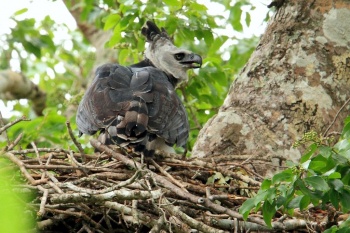- Harpia harpyja
Identification
Length 89–105 cm (35-41¾ in); wingspan 180-200 cm; weight (male) 4.0-4.8 kg, (female) 7.6-9.0 kg
The Harpy Eagle is one of the heaviest and most powerful of eagles, though as a forest-dwelling bird, relatively short-winged compared to other large eagles to increase its manoeuvrability through tree canopies. What does mark it out from all other eagles, however is the immense size of its feet and talons, and the thickness of its legs.
- Adults: grey head with black throat band
- Immatures: pale grey head with light grey throat band
- Short, dark, divided crest
- White breast
- Blackish upperparts
- Tail with broad black and white bars
Similar species
Crested Eagle, which occurs in the same areas, is similar though substantially smaller, and relatively longer-tailed.
Distribution
Central and South America: very rare in Mexico reported from Veracruz, Chiapas and Campeche, also from Belize and Guatemala south to Panama and in South America from Colombia, Venezuela and the Guianas south to southeast Brazil and northeast Argentina.
Taxonomy
This is a monotypic species[1].
Habitat
Primary lowland rainforest, mainly below 800 m, rarely as high as 1,600 m altitude. Occasionally soars over forest and sometimes perches on the highest treetops but spends much time in dense canopy foliage.
Behaviour
Diet
Their diet includes big animals such as sloths and howler and capuchin monkeys; males take prey in the 0.5-2.3 kg range, while females take prey 2.7-9 kg weight.
Breeding
The nests are situated high up in the crowns of silk-cotton trees about 50-75 m tall. Made of sticks up to 4 cm thick,the nest is 1.5 m across and lined with green leaves and animal hair. Two eggs may be laid, but it is normal for only one young eaglet to be reared.
Vocalisation
Call: a loud wailing wheeeeeee or wheeeeoooo.
Movements
A resident species.
References
- Clements, J. F., T. S. Schulenberg, M. J. Iliff, D. Roberson, T. A. Fredericks, B. L. Sullivan, and C. L. Wood. 2017. The eBird/Clements checklist of birds of the world: v2017, with updates to August 2017. Downloaded from http://www.birds.cornell.edu/clementschecklist/download/
- Del Hoyo, J, A Elliot, and J Sargatal, eds. 1994. Handbook of the Birds of the World. Volume 2: New World Vultures to Guineafowl. Barcelona: Lynx Edicions. ISBN 978-8487334153
- Handbook of the Birds of the World Alive (retrieved February 2015)
Recommended Citation
- BirdForum Opus contributors. (2025) Harpy Eagle. In: BirdForum, the forum for wild birds and birding. Retrieved 26 April 2025 from https://www.birdforum.net/opus/Harpy_Eagle
External Links
GSearch checked for 2020 platform.1






